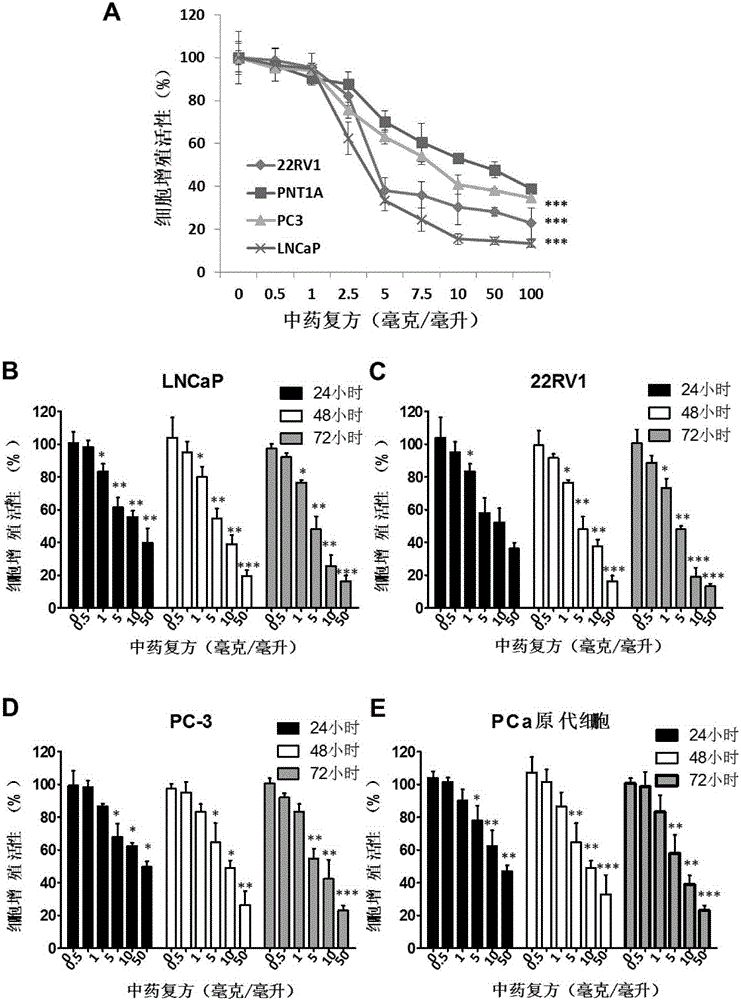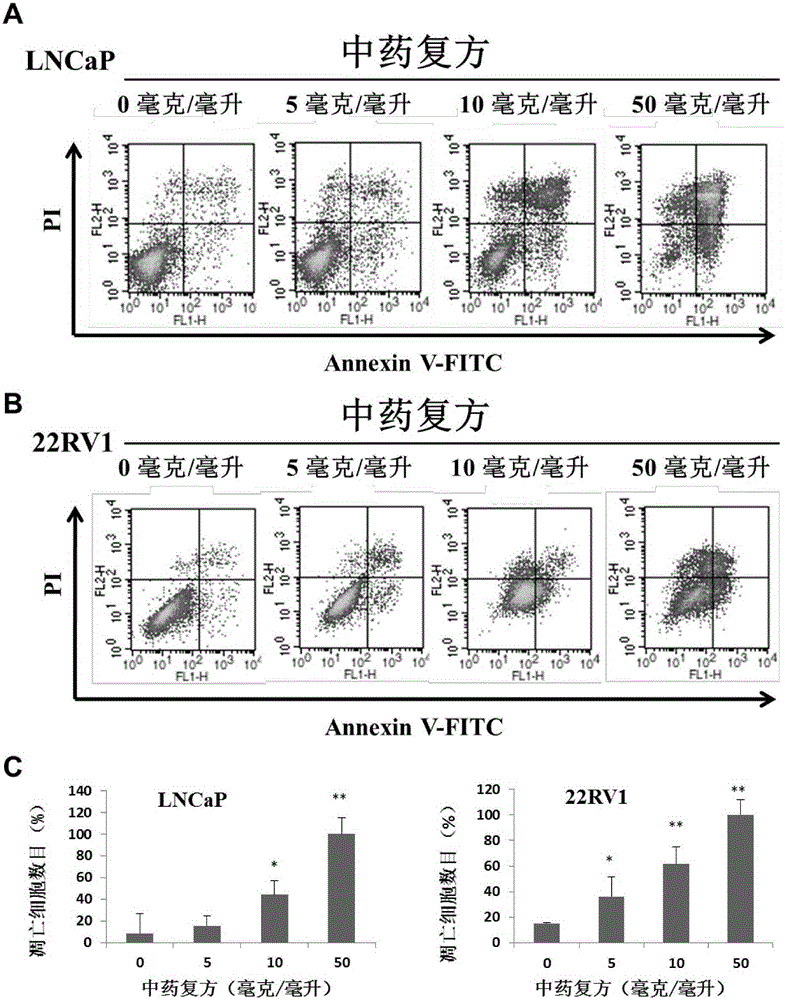Compound traditional Chinese medicine composition and application thereof to resistance to prostate cancer
A prostate cancer and composition technology, applied in the field of medicine, can solve the problems of poor economic affordability of patients, limited treatment effect, high cost, etc., and achieve the effect of inhibiting proliferation, improving sensitivity, and treating advanced castration-resistant prostate cancer
- Summary
- Abstract
- Description
- Claims
- Application Information
AI Technical Summary
Problems solved by technology
Method used
Image
Examples
Embodiment 1
[0104] Embodiment 1: the preparation of Chinese medicine compound composition of the present invention
[0105] The traditional Chinese medicine compound composition with anti-prostate cancer effect in this example is made from the following raw materials: 9 parts of Ailanthus sinensis bark, 30 parts of Hedyotis diffusa, 15 parts of Curcuma zedoary, 30 parts of Salvia miltiorrhiza, 15 parts of Prunella vulgaris, and 9 parts of licorice , adding 15 times the volume of the traditional Chinese medicine compound composition in distilled water and soaking for 3 hours; decocting in an automatic Chinese medicine decoction device, the number of decoctions is 2 times, and decocting for 1 hour each time; Open the cover on the automatic decoction device and evaporate to concentrate until the final volume is 70 ml; the final concentration of the mother liquor of Chinese medicine decoction obtained by concentration is about 1.5 g of crude drug / ml. Filter and sterilize the obtained concentr...
Embodiment 2
[0107] Example 2: Inhibition of the proliferative activity and clone formation of the compound Chinese medicine composition of the present invention on different prostate cancer cells and the induction of apoptosis on different prostate cancer cells
[0108] Technical method:
[0109] 1. Cell Culture
[0110] The cells (LNCaP, 22RV1, PC-3, PNT1A) used in this experiment were all purchased from the Shanghai Cell Bank of the Chinese Academy of Sciences; the other cell line came from primary isolated prostate cancer cells derived from tumor tissue of prostate cancer patients in Shanghai Changhai Hospital ( PCa primary cells), the cells were cultured in a constant temperature incubator at 37 degrees Celsius (humidity 95%, CO 2 concentration 5%), the medium was RPMI-1640 (Gibco) containing 10% fetal bovine serum (Front).
[0111] 2. Determination of cell proliferation by SRB (sulfonyl rhodamine) method
[0112] Different prostate cancer cell lines in 5×10 3 Each / well density wa...
Embodiment 3
[0120] Example 3: Inhibition of the compound Chinese medicine composition of the present invention on the migration and invasion of prostate cancer cells
[0121] Technical method:
[0122] 1. Streak Migration Experiment
[0123] In order to study whether the Chinese medicine compound composition of the present invention inhibits the lateral migration of prostate cancer cells, PC-3 cells are seeded into 6-well plates, and the 2 Routine culture in the incubator for 24 hours until the cells grow to 100% full. Replace the serum-free medium and continue to culture for 12 hours. In the culture wells full of cells, scratch with a 200 microliter sterile pipette tip, wash the cells twice with PBS after scratching, absorb the floating cells, and add 1 ml of complete medium to each well. Add different concentrations of traditional Chinese medicine compound compositions to the cell culture wells, and place the culture plate in CO 2 Incubator, 37 degrees Celsius to continue routine cu...
PUM
 Login to View More
Login to View More Abstract
Description
Claims
Application Information
 Login to View More
Login to View More - R&D
- Intellectual Property
- Life Sciences
- Materials
- Tech Scout
- Unparalleled Data Quality
- Higher Quality Content
- 60% Fewer Hallucinations
Browse by: Latest US Patents, China's latest patents, Technical Efficacy Thesaurus, Application Domain, Technology Topic, Popular Technical Reports.
© 2025 PatSnap. All rights reserved.Legal|Privacy policy|Modern Slavery Act Transparency Statement|Sitemap|About US| Contact US: help@patsnap.com



